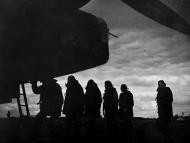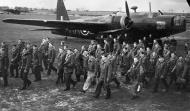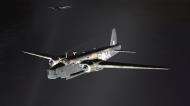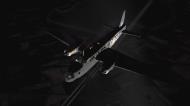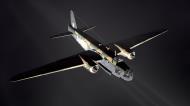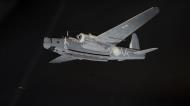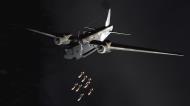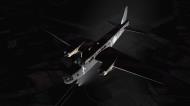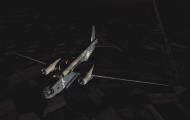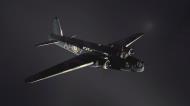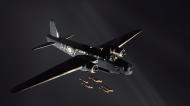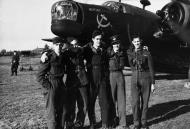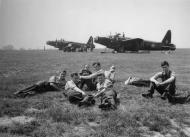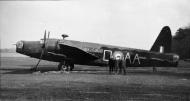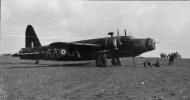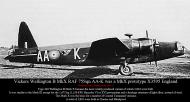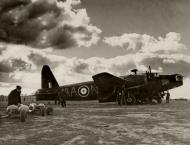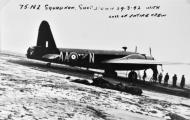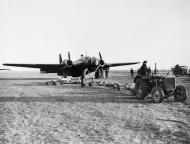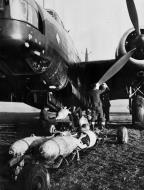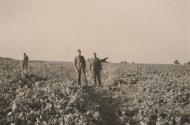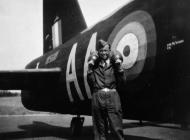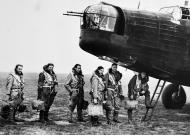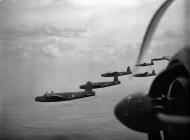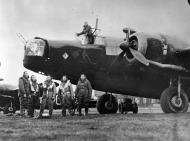No. 75 RFC / RAF History
No. 75 Squadron Royal Flying Corps (later RAF) was formed as a home defence fighter unit on 1 October 1916 but disbanded in June 1919 following the end of World War I. The squadron reformed at RAF Feltwell in Norfolk on 15 March 1937 as part of the RAF expansion in the mid-1930s, with transfer of pilots from No. 215 Squadron RAF, being equipped with four Vickers Virginias and seven Avro Ansons for bomber training. The squadron later operated Handley Page Harrows which were replaced by Ansons in 1939, operating again in a training role alongside No 15 Operational Training Unit. Meanwhile, the New Zealand government had ordered 30 modern Vickers Wellington bombers to replace its Vickers Vildebeests in New Zealand. Aircrew were sent to England to train on these new aircraft before flying them back to New Zealand.
75 (NZ) Squadron
In August 1939, with war seeming increasingly likely, the New Zealand government offered to place both men and machines at the disposal of Britain. They were allocated the "75" squadron number and the squadron officially became No. 75 (New Zealand) Squadron, RAF on 4 April 1940. It was one of the first of the "bracket" squadrons. Ultimately, six other New Zealand units, as well as many from other countries, were formed within the RAF, until the practice ceased in 1942. These squadrons were usually formed around aircrews from the named nation, replacement aircrew where possible coming from that nation as well, although most ground crew were British.
World War II
The squadron was progressively equipped with Wellingtons, Short Stirlings, Avro Lancasters and finally Avro Lincolns, which it was preparing to take to the Far East as part of Tiger Force when Japan surrendered. Some have claimed that No 75 Squadron it to be the only squadron engaged constantly against Germany from 1939 to VE day. However, as the 75 (NZ) Sqn only stood up in April 1940, this is not correct. It flew more sorties than any other RAF heavy bomber unit, suffered more casualties than any other squadron, and dropped the second-largest weight of bombs. A pilot of the Squadron was awarded a VC in 1941, Sergeant James Allen Ward climbed along the wing of a Wellington in flight, in an attempt to extinguish a fire from an engine after a night fighter attack.
No 75(NZ) Squadron RAF saw action early over France, Norway and most other European nations, but principally against Germany. The squadron was part of the first major bombing raid on Germany, a night raid on oil infrastructure in the Ruhr on 15 May 1940. In September that year the squadron took part in the first large-scale bombing of Berlin.
In March 1944, No. 75(NZ) Sqn began to exchange its Stirlings for Lancaster III's and was ready in time to participate in preparation and support of the Allied invasion, the bombing of flying-bomb sites and close-support of the armies. A Lancaster, (ND917), a Mark III captained by Squadron Leader N A Williamson, RNZAF, on 30 June 1944 became the first British heavy bomber to land in Normandy after the invasion began. The Lancaster was returning from an attack on Villers Bocage in support of the Army when Williamson landed on one of the newly laid landing strips on the beach-head to seek medical aid for his flight engineer who had been wounded by flak.
An unusual sortie for 75(NZ) Squadron was the high altitude run over The Hague in March 1945 by a lone Lancaster piloted by Flight Lieutenant H W Hooper. He dropped thousands of leaflets containing an apology from the British government for the earlier Allied bombing of the city which had been an error.
Bibliography:
- Andrews, C.F. The Vickers Wellington I & II (Aircraft in Profile 125). Leatherhead, Surrey: Profile Publications Ltd., 1970, First edition 1967. No ISBN.
- Andrews, C.F and E.B. Morgan. Vickers Aircraft since 1908. London: Putnam, 1988. ISBN 0-85177-815-1.
- Bowman, Martin. Wellington, The Geodetic Giant. Shrewsbury, UK: Airlife Publishing Ltd., 1989. ISBN 1-85310-076-5.
- Bowyer, Chaz. Wellington at War. Shepperton, Surrey: Ian Allan Ltd., 1982. ISBN 0-7110-1220-2.
- Bowyer, Chaz. Wellington Bomber. London: William Kimber & Co Ltd., 1986. ISBN 0-7183-0619-8.
- Cooksley, Peter G. Wellington, Mainstay of Bomber Command. Wellingborough, Northhamptonshire: Patrick Stephens Ltd., 1987. ISBN 0-85059-851-6.
- Crosby, Francis. The World Encyclopedia of Bombers. London: Anness Publishing Ltd., 2007. ISBN 1-84477-511-9.
- Delve, Ken. Vickers Armstrong Wellington. Ramsbury, Wiltshire, UK: The Crowood Press Ltd., 1998. ISBN 1-86126-109-8.
- Flintham, V. Air Wars and Aircraft: A Detailed Record of Air Combat, 1945 to the Present. New York: Facts on File, 1990. ISBN 0-8160-2356-5.
- Gilman J.D. and J. Clive. KG 200. London: Pan Books Ltd., 1978. ISBN 0-85177-819-4.
- Hall, Alan W. Vickers Wellington, Warpaint Series No. 10. Husborne Crawley, Berfordshire: Hall Park Books Ltd., 1997. No ISBN.
- Jackson, Robert. Britain's Greatest Aircraft. Barnsley, UK: Pen & Sword Books Ltd., 2007. ISBN 978-1-84415-383-1.
- Lihou, Maurice. Out of the Italian Night: Wellington Bomber Operations 1944-45. Shrewsbury, UK: Airlife Publishing Ltd., 2003. ISBN 1-84037-405-5.
- Lumsden, Alec. Wellington Special. Shepperton, Surrey: Ian Allan Ltd., 1974. ISBN 0-7110-0527-3.
- Mackay, Ron. Wellington in Action, Aircraft Number 76. Carrollton, Texas: Squadron/Signal Publications, Inc., 1986. ISBN 0-89747-183-0.
- Murray, Dr. Iain Bouncing-Bomb Man: The Science of Sir Barnes Wallis. Haynes. ISBN 978-1-84425-588-7.
- Ovčáčík, Michal and Karel Susa. Vickers-Armstrongs Wellington Medium Bomber variants. Prague, Czech Republic: 4+ Publications, 2003. ISBN 80-902559-7-3.
- Richards, Denis. The Hardest Victory: RAF Bomber Command in the Second World War. London: Coronet Books, 1995. ISBN 0-340-61720-9.
- Richards, Denis. Royal Air Force 1939–1945: Volume I The Fight at Odds. London: HMSO, 1953.
- Tarring, Trevor and Mark Joseland. Archie Frazer-Nash .. Engineer. London: The Frazer Nash Archives, 2011. ISBN 978-0-9570351-0-2.
Web References: +
- History of RAF Organisation: http://www.rafweb.org
- IWM London Lambeth Road London SE1 6HZ Webstite http://www.iwm.org.uk
- Wikipedia, the free encyclopedia: http://en.wikipedia.org/
 Editor for Asisbiz: Matthew Laird Acred
Editor for Asisbiz: Matthew Laird Acred
If you love our website please add a like on facebook
Please donate so we can make this site even better !!

